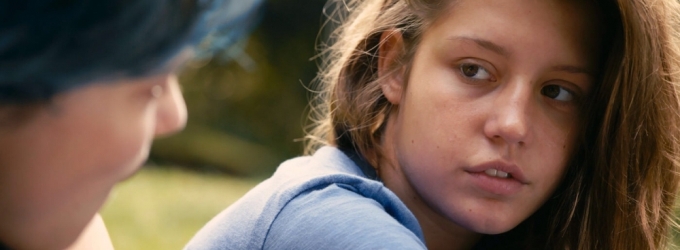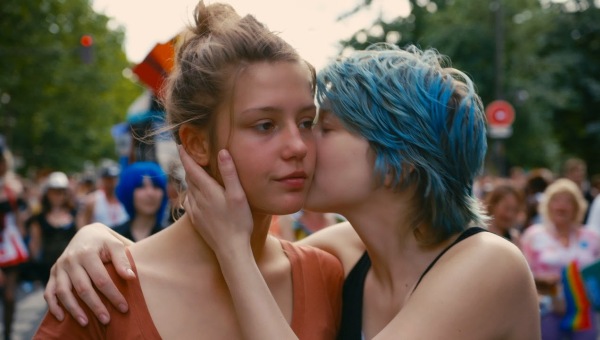 If you want see, touch and feel the highs and lows of young love in a way that only cinema can conjure, then BLUE IS THE WARMEST COLOUR is the film for you. It’s an extraordinarily vivid portrayal of a romantic relationship, from the giddy upswing of its early halcyon days to its later violent and traumatic collapse. It even manages to transcend the highly misleading, and slightly distasteful, lesbian love drama label that it has been stuck with ever since it wowed audiences at Cannes earlier this year, where it collected the Palme d’Or.
If you want see, touch and feel the highs and lows of young love in a way that only cinema can conjure, then BLUE IS THE WARMEST COLOUR is the film for you. It’s an extraordinarily vivid portrayal of a romantic relationship, from the giddy upswing of its early halcyon days to its later violent and traumatic collapse. It even manages to transcend the highly misleading, and slightly distasteful, lesbian love drama label that it has been stuck with ever since it wowed audiences at Cannes earlier this year, where it collected the Palme d’Or.
In some ways the film is a BRIEF ENCOUNTER for the 21st century. One of the most memorable scenes in David Lean’s film is when Celia Johnson’s character suddenly realises she has said her final goodbye to would-be lover Trevor Howard, and will never see him again. The camera gradually tilts at an angle and zooms in on her to the sound of a train whistle, as the rush of emotion and heartache becomes too much to bear. She rushes on to the station platform and nearly into the path of the oncoming train; she stops, and gradually the urge to end the pain subsides. A similar sensation of nausea and heartache occurs in the second half of Abdellatif Kechiche’s epic exploration of love, though less artfully shown, when the central relationship receives a significant blow; the shock and gasping agony is plain to see (and feel) in the faces of the two women. It’s a powerful and riveting scene, whose immediacy is unlike anything else seen at the cinema this year.
The romance is honest, the bond palpable.
The film itself is divided in to two parts, though there is no obvious dividing line (the closing credits indicate its original title was “ADELE: CHAPTERS 1 & 2”). The first half portrays the beginning of the relationship and the second half the end, both in equally forensic detail. Adèle (a beautifully natural turn by Adèle Exarchopoulos) is a high school student whose romantic entanglements with the opposite sex have so far proven to be disappointing. As a brief flirtation with a guy ends, she spies Emma (an equally good Léa Seydoux), a college student who exudes confidence and happens to be openly gay. Adèle finds herself inexplicably drawn to her, and before long the couple are thrown in to a passionate relationship.
Adèle’s inward confusion and outward torment at the hands of her school friends is countered by the joy of finding true love for the first time. Kechiche leaves nothing to the imagination; the sex scenes are indeed as graphic as you’ve heard, and if the film has a fault then it is one of overlength. Besides its three hour running time, the sex in a couple of scenes runs for such an uncomfortably long time that they begin to verge on bad porn parody. But the counter argument is that by sticking with the couple through the entire spectrum of the relationship, from public courtship to private conversations to intimate physicality, the audience are fully invested in the final outcome.
And what an outcome it is. Without wishing to spoil the story, the relationship takes a downward turn in the second half that fully captures the swirling emotional chaos that a break-up can incur. Largely devoid of a musical soundtrack, the story of Adèle and Emma also lacks any sense of melodrama or cliché. The romance is honest, the bond palpable. This is one of the finest love stories to have emerged on the big screen in many years. It might be flawed, but it’s also something of a minor miracle.
httpvh://youtu.be/jCKHZu36BoQ


It matters little which is right, but I believe that Adèle has seen Emma before she sleeps with Thomas – the masturbatory dream features Emma before we know who she is (in relation to Adèle).
As to the romance being honest, the bond palpable, I found myself using ‘hollow’ in my review to describe how their relationship felt, and Adèle as ‘very reserved’ and ‘even awkward’ (except in bed, where she acts as if she’s made love to women all her live) – she even looks it in the still from the live action (above)…
Felt anything but hollow to me – yes, Adele is certainly hesitant and reserved initially, but the shared connection with Emma grows steadily throughout, for me at least. Later on it becomes apparent they are drifting apart, but that’s after a gap of (presumably) a few years.
Well, apart from two meals, one each with Emma’s and Adèle’s parents, we really just jump to when Adèle is teaching / doing teaching practice, and saying that she hopes to join her male colleague for drinks after what is the significant party. (Even being outed (falsely, though Adèle makes this good) somehow has no consequences for a girl still in high school with animatedly hostile fellow students.)
For me, the connection is more rooted in admiration for each other’s skills, although the conversation about what ‘beaux arts’ and why there not ugly arts is unconvincing as a conversation about art on any level, not unlike those at the party (Schiele versus Klimt).